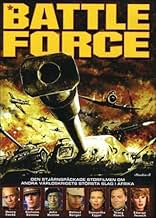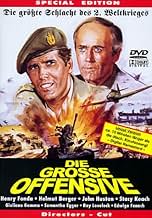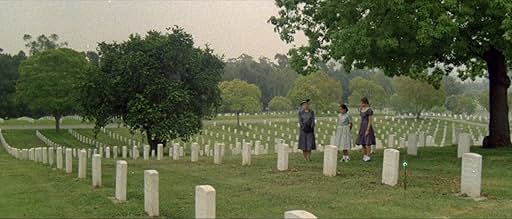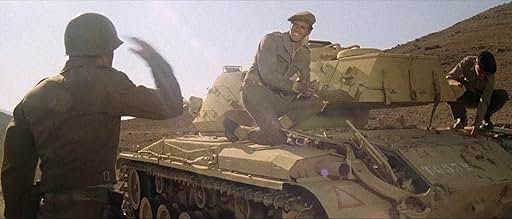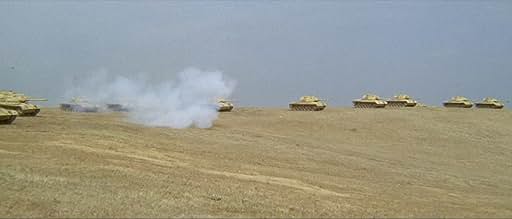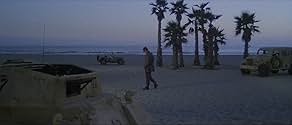IMDb RATING
4.7/10
626
YOUR RATING
How World War II affected the lives of a German family and an American family, both of whom had sons and fathers fighting in the war.How World War II affected the lives of a German family and an American family, both of whom had sons and fathers fighting in the war.How World War II affected the lives of a German family and an American family, both of whom had sons and fathers fighting in the war.
Ida Galli
- Sybil Scott
- (as Evelyn Stewart)
Rik Battaglia
- French Partisan
- (as Rick Battaglia)
Featured reviews
This spectacular movie starts in Berlin during Oympic Games 1936 with the African-American Jesse Owens as champion . There reunites a Nazi officer (Stacy Keach) , a veteran American journalist (John Huston), a famous actress (Samantha Eggar) and an US General (Henry Fonda). Keach gives gifts to the hosts captioning : 'In God we trust' . The group of different nationalities vows to meet five years later but WWII interrupts their lives . Los Angeles 1942 , the upright General incarnated by Henry Fonda is assigned to West Point Academy and his son (Ray Lovelock) takes the ranks to North African campaign . After the action is placed on several locations , as London , West Point, Le Hauvre (France) . Island of Creta , October 1942, an official (Giuliano Gemma) whose mission is to destroy a German installation before being used against the Allied forces . Following the feats about Partisans and a parachuted squadron (led by Giacomo Rossi Stuart) attacking a train (commanded by Helmut Berger) transporting a big German-built cannon (whose scenes are taken from ¨Battle of commands¨). Meanwhile the German actress (Samantha Eggar)for the reason his Jewish origin is detained by SS and Nazi official Berger is enamored to prostitute (gorgeous Edwige Fenech) . Posteriorly , it tells battles in Mareth line March 14, 1943 and Gabes , North Africa , engaging war German Army against British VIII army . There a captain (Gemma) neutralizes a bomb camp and Nazi officer (Berger) impersonates Allied soldier to destroy supplies . Taking place spectacular battles with miniaturized tanks (whose footage is taken from ¨Battle of Alaimen¨ by Giorgo Ferroni and the same producer Mino Loy) .
This is a regularly conceived WWII with action filled , studio character , drama and exciting battles , but nothing special . Packs inaccurate details and an extremely talented though wasted cast make this one of all-time great Italian epic productions though failed . The film contains news-reel documentary , stock-shots vignettes and miniatures , however lost continuity with several cuts and zooms . The battle scenes were shot in desert of Tabernas (Almeria) where in the 60s and 70s were filmed lots of Westerns . Furthermome, a prestigious cast , as Fonda , Eggar , Keach and appears as narrator the great Orson Welles . Numerous Italian secondaries as Jack Stuart , Andrea Bosic , Venantino Venanti , Ken Wood , Ida Valli and Rick Battaglia habitual of Peplum and Spaghetti . The tale was middlingly directed by Umberto Lenzi , he often used the pseudonym Hank Milestone and Humphrey Logan . He's an expert on wartime genre such as he proved in ¨ Desert commandos¨ , ¨Battle of commandos¨, ¨From hell to victory¨, and ¨Bridge to hell¨.
This is a regularly conceived WWII with action filled , studio character , drama and exciting battles , but nothing special . Packs inaccurate details and an extremely talented though wasted cast make this one of all-time great Italian epic productions though failed . The film contains news-reel documentary , stock-shots vignettes and miniatures , however lost continuity with several cuts and zooms . The battle scenes were shot in desert of Tabernas (Almeria) where in the 60s and 70s were filmed lots of Westerns . Furthermome, a prestigious cast , as Fonda , Eggar , Keach and appears as narrator the great Orson Welles . Numerous Italian secondaries as Jack Stuart , Andrea Bosic , Venantino Venanti , Ken Wood , Ida Valli and Rick Battaglia habitual of Peplum and Spaghetti . The tale was middlingly directed by Umberto Lenzi , he often used the pseudonym Hank Milestone and Humphrey Logan . He's an expert on wartime genre such as he proved in ¨ Desert commandos¨ , ¨Battle of commandos¨, ¨From hell to victory¨, and ¨Bridge to hell¨.
This film has the unmistakable whiff of tax write off about it and I can't believe the non-Italians in this Italian made World War II film weren't doing this one for nothing more than a paycheck and a European vacation.
For an Italian film you would think Italy would be mentioned somewhere in this story. The climax of the movie is the battle for Tunisia where the Italians had a lot of soldiers. The battle scenes are merely stock footage from other and better films.
The only tie in this whole story is a meeting in Berlin of retired army general Henry Fonda, war correspondent John Huston, German-Jewish actress Samantha Eggar and German major Stacy Keach. Meeting at the time of the Olympics there, the four dismiss the possibility of war.
After that it seems like you're watching four or five separate films all at once. Everyone seems to be just reciting the dialog by rote and hurrying off to do better things presumably. Even Orson Welles who narrates the English language version, can't whip up any excitement in his voice.
It's just another one done for the money.
For an Italian film you would think Italy would be mentioned somewhere in this story. The climax of the movie is the battle for Tunisia where the Italians had a lot of soldiers. The battle scenes are merely stock footage from other and better films.
The only tie in this whole story is a meeting in Berlin of retired army general Henry Fonda, war correspondent John Huston, German-Jewish actress Samantha Eggar and German major Stacy Keach. Meeting at the time of the Olympics there, the four dismiss the possibility of war.
After that it seems like you're watching four or five separate films all at once. Everyone seems to be just reciting the dialog by rote and hurrying off to do better things presumably. Even Orson Welles who narrates the English language version, can't whip up any excitement in his voice.
It's just another one done for the money.
I'm not a fan of war films to say the least and if I'm going to sit down and watch one, there generally has to be a real good reason for doing so. Despite the fact that Battle Force is a largely unknown and inconsequential war film from the late seventies; I actually did have several good reasons for seeing it. Anything directed by Umberto Lenzi is automatically worth watching considering all the great cult films he has delivered; from some of the best Giallo's to the very best of the Polizi genre, and adding to that is absolutely mouth-watering cast. However, in spite of those things; this is still a highly disappointing and really rather rubbish movie. The plot is rather confusing and doesn't make much sense and mainly focuses on two families of different nationalities during World War Two. However, we also focus on the actual war itself and various battles that the characters are involved in and this all gets mingled in with the stories of the families...
The main problem with this film is that it tries to do too much and the one hundred minute running time is simply not long enough for it to do it all in (although I am thankful that the film didn't last for longer!). I don't really know how credible Umberto Lenzi was as a director in 1978 (probably more credible than he was in the eighties), but somehow he has managed to get his hands on a magnificent cast chequered with stars - and not just cult stars! Big names such as John Huston, Henry Fonda and Orson Welles have roles alongside cult stars such as Ray Lovelock, Samantha Eggar, Evelyn Stewart, Stacy Keach, Helmut Berger and Edwige Fenech (who really doesn't appear for long enough). This cast is all well and good but unfortunately it's wasted. The plot lacks any sort of direction and the film might actually have been better as an anthology style movie with a few different but focused stories. The war scenes look extremely cheap (the budget was probably spent on paying stars' wages) and that also brings the film down, although there is plenty of action. Overall, this did actually have the potential to be a masterpiece; but to say the least, it isn't! Recommended for its cult value only.
The main problem with this film is that it tries to do too much and the one hundred minute running time is simply not long enough for it to do it all in (although I am thankful that the film didn't last for longer!). I don't really know how credible Umberto Lenzi was as a director in 1978 (probably more credible than he was in the eighties), but somehow he has managed to get his hands on a magnificent cast chequered with stars - and not just cult stars! Big names such as John Huston, Henry Fonda and Orson Welles have roles alongside cult stars such as Ray Lovelock, Samantha Eggar, Evelyn Stewart, Stacy Keach, Helmut Berger and Edwige Fenech (who really doesn't appear for long enough). This cast is all well and good but unfortunately it's wasted. The plot lacks any sort of direction and the film might actually have been better as an anthology style movie with a few different but focused stories. The war scenes look extremely cheap (the budget was probably spent on paying stars' wages) and that also brings the film down, although there is plenty of action. Overall, this did actually have the potential to be a masterpiece; but to say the least, it isn't! Recommended for its cult value only.
Director Umberto Lenzi's movies have always been the subject of criticism on web boards and even from nationally known reviewers, including Leonard Maltin. It seems as though he takes a lot of flak simply because his films are made overseas. At its heart, "The Greatest Battle" is really no better or worse than the slew of epic war films to come out of Hollywood in the 1970s.
During the Berlin Olympics of 1936, German Major Roland (Stacy Keach); American General Foster (Henry Fonda); reporter Sean O'Hara (John Huston) and Jewish actress Annelise Ackerman (Samantha Eggar) meet and become friends. Flash forward to late 1941: America is embroiled in World War II. Several more characters are introduced, namely: Foster's loser son, John (Ray Lovelock); gutsy British commando leader Captain Scott (Giuliano Gemma) and dedicated Nazi commando officer Lt. Zimmer (Helmut Berger). All of these characters become interconnected over the course of the next two years and wind up coming face-to-face at the Battle of the Mareth Line in North Africa. Each turn in a dedicated, honest performance something to be admired in this genre.
Several familiar European actors appear in the supporting cast, and although their parts are unimportant to the storyline, it's essential to mention some of them: Giacomo Rossi-Stuart ("Hornets' Nest") plays John Foster's commander; Andrea Bosic ("Hell's Brigade") as the leader of Greek partisans; Ida Galli ("Eagles Over London") as Scott's estranged wife, and Venantino Venantini ("The War Devils") as her new husband; Geoffrey Copleston ("The Assisi Underground") as a menacing SS Colonel; Luciano Catenacci ("The Battle of El Alamein") as a British radio operator; the list goes on forever. Even Orson Welles ("The Battle of Neretva") narrates the proceedings rather unnecessarily and, often, incorrectly.
For the most part, this is a plot less series of scenes, chronicling major events in the characters' lives and campaigns. Lenzi fills out the running time with stylistic action sequences and well-integrated stock footage. Lenzi's directorial style and energy are apparent in a number of battle scenes. He takes a lot of ideas and scenarios from his earlier war films notably, "Battle of the Commandos" (a partisan ambush of a German armored convoy looks awfully familiar, as does a commando raid on a coastal bunker) and shoots them with a bigger budget and more professionalism. The Federico Zanni photography is simply dazzling and excellently edited by Eugenio Alabiso, one of my favorite genre-editors.
Unfortunately, a lot of familiar stock footage from "Battle of the Commandos", "Commandos", "Desert Assault" and "The Battle of El Alamein" is used as a substitute for original action footage, which really hampers the original, epic feel of the movie. But look at Hollywood's epic "Midway" released in 1976: it's a hodgepodge of stock footage and cameos, yet is much better received by audiences than this film. The major action sequences revolve solely around the stock footage, but that's okay in this movie, because the material surrounding these sequences is so good.
The production values are amazingly high in this film, setting it another notch among its' peers. The sets, from Parisian bars and brothels, to huge entrenchments, fuel dumps and railroad stations look fantastic. The costumes and props are appropriate, too. There are hundreds of extras, tanks, APCs, jeeps and airplanes dotting the screen, giving the film the appropriate epic look.
This Italian-produced war epic is typically underrated and undeserving of the criticism it so often receives. While it does lack a storyline and has no character development whatsoever and contains reels of stock footage, the original material, style and slew of actors help to offset these flaws. "The Greatest Battle" is no better or worse than any similar film made in Hollywood, and is certainly much more entertaining and engaging than titles like "Midway".
During the Berlin Olympics of 1936, German Major Roland (Stacy Keach); American General Foster (Henry Fonda); reporter Sean O'Hara (John Huston) and Jewish actress Annelise Ackerman (Samantha Eggar) meet and become friends. Flash forward to late 1941: America is embroiled in World War II. Several more characters are introduced, namely: Foster's loser son, John (Ray Lovelock); gutsy British commando leader Captain Scott (Giuliano Gemma) and dedicated Nazi commando officer Lt. Zimmer (Helmut Berger). All of these characters become interconnected over the course of the next two years and wind up coming face-to-face at the Battle of the Mareth Line in North Africa. Each turn in a dedicated, honest performance something to be admired in this genre.
Several familiar European actors appear in the supporting cast, and although their parts are unimportant to the storyline, it's essential to mention some of them: Giacomo Rossi-Stuart ("Hornets' Nest") plays John Foster's commander; Andrea Bosic ("Hell's Brigade") as the leader of Greek partisans; Ida Galli ("Eagles Over London") as Scott's estranged wife, and Venantino Venantini ("The War Devils") as her new husband; Geoffrey Copleston ("The Assisi Underground") as a menacing SS Colonel; Luciano Catenacci ("The Battle of El Alamein") as a British radio operator; the list goes on forever. Even Orson Welles ("The Battle of Neretva") narrates the proceedings rather unnecessarily and, often, incorrectly.
For the most part, this is a plot less series of scenes, chronicling major events in the characters' lives and campaigns. Lenzi fills out the running time with stylistic action sequences and well-integrated stock footage. Lenzi's directorial style and energy are apparent in a number of battle scenes. He takes a lot of ideas and scenarios from his earlier war films notably, "Battle of the Commandos" (a partisan ambush of a German armored convoy looks awfully familiar, as does a commando raid on a coastal bunker) and shoots them with a bigger budget and more professionalism. The Federico Zanni photography is simply dazzling and excellently edited by Eugenio Alabiso, one of my favorite genre-editors.
Unfortunately, a lot of familiar stock footage from "Battle of the Commandos", "Commandos", "Desert Assault" and "The Battle of El Alamein" is used as a substitute for original action footage, which really hampers the original, epic feel of the movie. But look at Hollywood's epic "Midway" released in 1976: it's a hodgepodge of stock footage and cameos, yet is much better received by audiences than this film. The major action sequences revolve solely around the stock footage, but that's okay in this movie, because the material surrounding these sequences is so good.
The production values are amazingly high in this film, setting it another notch among its' peers. The sets, from Parisian bars and brothels, to huge entrenchments, fuel dumps and railroad stations look fantastic. The costumes and props are appropriate, too. There are hundreds of extras, tanks, APCs, jeeps and airplanes dotting the screen, giving the film the appropriate epic look.
This Italian-produced war epic is typically underrated and undeserving of the criticism it so often receives. While it does lack a storyline and has no character development whatsoever and contains reels of stock footage, the original material, style and slew of actors help to offset these flaws. "The Greatest Battle" is no better or worse than any similar film made in Hollywood, and is certainly much more entertaining and engaging than titles like "Midway".
Not bad at all for an Italian war spaghetti film. Of course it is not BATTLE OF THE BULGE, BATTLE OF ENGLAND nor THE LONGEST DAY either but the international cast helps much. Not a bad story, not so far from historical accuracy, good convincing acting and poignant scenes too. Excellent battle sequences. I have seen far worse in terms of Italian spaghetti war films. Here, at least, the German army - Afrika Korps - is not shown as silly soldiers - which they certainly were not - and a difference is made between SS - Gestapo - and the Wehrmacht. I enjoyed it very much. I guess there are many more films like this, Italian movie industry from the late sixties and late seventies provided so many of them.
Did you know
- GoofsIn one of the scenes the American Flag has fifty stars, as it does now, but that flag was not adopted until Monday, July 4, 1960. The flag that should have been shown, which the Americans during World War Two served under, was the forty eight-star Stars and Stripes, which was valid from Thursday July 4, 1912 to Friday July 3, 1959, and is even seen hanging high in Grand Central Station in Hitchcock's North by Northwest.
- Quotes
German in Danielle's room: A French whore should work with her hips and not her lips!
- Alternate versionsThe American release has been dubbed into English. The titles have been translated to English. However, on the Direct Source Special Products Home Video Release, the film remains dubbed in English, yet the opening and ending titles have been redone using modern computer technology. The opening features the title BATTLE FORCE, and credits the film's director Humphrey Longan as Humphrey Logan; credits actress Edwige Fenech as Edwige French; and claims the cast listing to be in alphabetical order, which it is not.
- ConnectionsEdited from La légion des damnés (1969)
- How long is The Biggest Battle?Powered by Alexa
Details
- Release date
- Countries of origin
- Languages
- Also known as
- The Biggest Battle
- Filming locations
- Venice, California, USA(beach scenes)
- Production companies
- See more company credits at IMDbPro
Contribute to this page
Suggest an edit or add missing content


